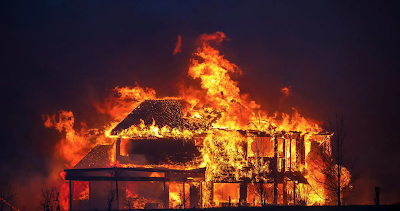A House on Fire
We've had an unexpected run of beautiful winter days for the last 10 days of the year with temps running from the low sixties to the low eighties. And we took full advantage of it in our outside addition that we built over the last few years in contemplation of Covid. Many nights were so warm, we didn't even use the outdoor fireplace. On Christmas eve, we not only shared gifts and chatted deep into the evening, we had a sit down dinner for eight on the east deck, complete with fine wines and baked salmon from the Northwest, where the weather is far colder than the region generally receives.
Meanwhile, strong winds and dry conditions burned down over a 1000 homes in Colorado. This from the NYTs:
"The fires began on Thursday morning and spread with astonishing speed across suburban neighborhoods in Boulder County. The authorities said around 6,200 acres were burned.
Sheriff Joe Pelle of Boulder County said on Thursday that he believed the fires had been started by downed power lines. However, investigators have not found any evidence of that.
While wildfires usually occur in Colorado’s mountainous region, far from where most of its residents live, the Marshall fire attacked drought-stricken suburban neighborhoods instead. "
The week before that, winter tornadoes attacked Kentucky. This from WLKY:
"Houses ripped from foundations, cars flipped and thrown, several lives lost and many unaccounted for.
The rare December tornadoes that ripped through Kentucky, and several other states, left communities across western Kentucky completely devastated. It is likely the worst storm to ever hit the state."
And of course, California has experienced another record year of fire. This from Wikipedia:
The 2021 California wildfire season is an ongoing series of wildfires that have burned across the state of California. As of December 16, 2021, a total of 8,619 fires have been recorded, burning 2,569,009 acres (1,039,641 ha) across the state.[1] At least 3,629 buildings have been destroyed by the wildfires, and at least seven firefighters and two civilians have been injured battling the fires.[1]
The wildfire season in California experienced an unusually early start amid an ongoing drought and historically low rainfall and reservoir levels.[2] In January 2021 alone, 297 fires burned 1,171 acres (4.74 km2) on nonfederal land according to the California Department of Forestry and Fire Protection, which is almost triple the number of fires and more than 20 times the acreage of the five-year average for January.[3][2] The January fires were exacerbated by unseasonably strong Santa Ana winds, and some of them burned in the same areas as previous fires like the CZU Lightning Complex.[4]
The long term trend is that wildfires in the state are increasing due to climate change in California.[5][6] In terms of the amount of fires burned, the 2021 season has been outpacing the 2020 season, which itself was the largest season in the state's recorded history. As of July 11, more than three times as many acres have burned compared to the previous year through that date, with drought, extreme heat, and reduced snowpack contributing to the severity of the fires."
We are warming in the US at .16 degrees F per decade according to the EPA:
- Since 1901, the average surface temperature across the contiguous 48 states has risen at an average rate of 0.16°F per decade (see Figure 1). Average temperatures have risen more quickly since the late 1970s (0.31 to 0.54°F per decade since 1979). Eight of the top 10 warmest years on record for the contiguous 48 states have occurred since 1998, and 2012 and 2016 were the two warmest years on record.
- Worldwide, 2016 was the warmest year on record, 2020 was the second-warmest, and 2011–2020 was the warmest decade on record since thermometer-based observations began. Global average surface temperature has risen at an average rate of 0.17°F per decade since 1901 (see Figure 2), similar to the rate of warming within the contiguous 48 states. Since the late 1970s, however, the United States has warmed faster than the global rate.
- Some parts of the United States have experienced more warming than others (see Figure 3). The North, the West, and Alaska have seen temperatures increase the most, while some parts of the Southeast have experienced little change. Not all of these regional trends are statistically significant, however.
Averaged across land and ocean, the 2020 surface temperature was 1.76° F (0.98° Celsius) warmer than the twentieth-century average of 57.0°F (13.9°C) and 2.14˚F (1.19˚C) warmer than the pre-industrial period (1880-1900).
So what is the big deal with temperatures going up by a degree or two? At 32 degrees, the 2 degree difference is the difference between rain and snow and a navigable waterway and unpredictable ice.
Imagine an ancient culture that lives on a bountiful lake that never froze over until one day it did. Even the elders had never seen such a thing. All at once, their food supply was only available by ice hole fishing. Their canoes were frozen in place along with their nets. The plants they harvested were now frozen and limp in their beds. Their world had changed with a seemingly insignificant 2% change in the temperature.
Now with our 2% change, a warming of 2 degrees, who would have imagined that the forest in our temperate regions would begin to combust, to catch on fire, and to change the landscapes that our elders have known for generations.
The giant redwoods...gone.
The 100 year old homes nestled deep in the woods...gone.
The towns that grew up in the cooling shade of arboreal splendor...gone.
The cities that flourished alongside our great forested areas...gone too?
Our house is on fire,
and the firemen brought an axe.
Earthfamily Principles
Earthfamilyalpha you tube channel
Earthfamilyalpha Content IV
Earthfamilyalpha Content III
Earthfamilyalpha Content II
Earthfamilyalpha Content
Labels: climate change, earthfamily, environment, the world
